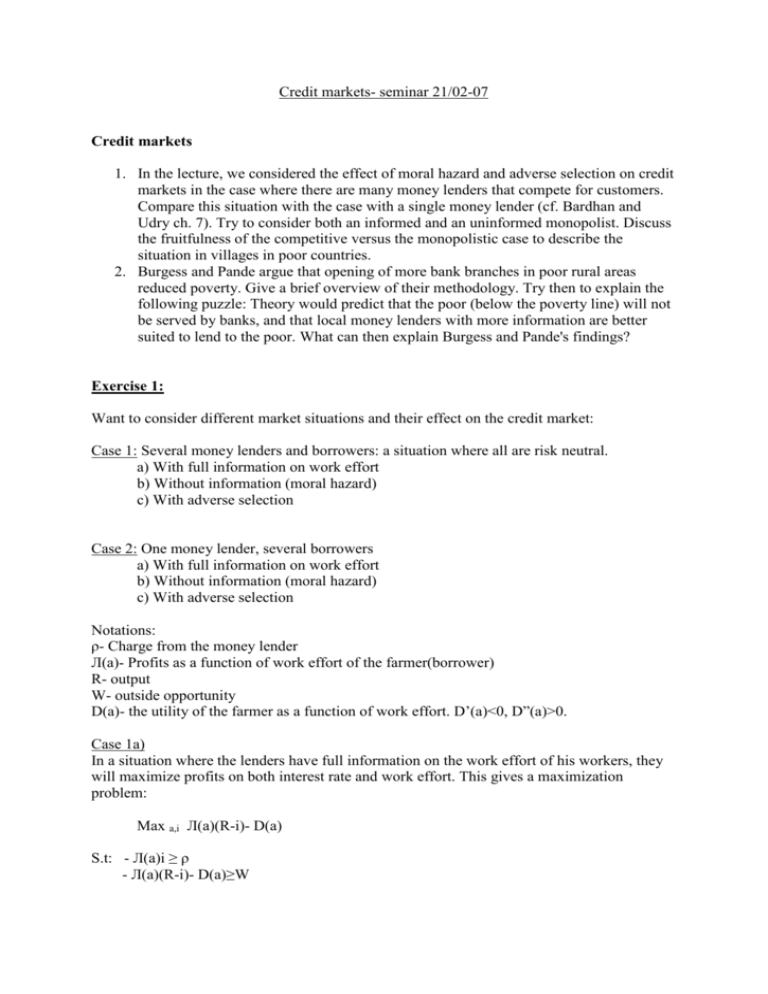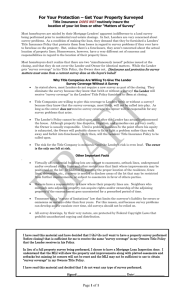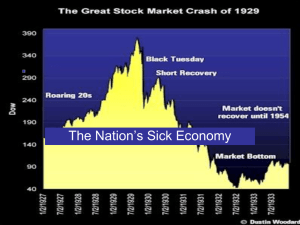Credit markets- seminar 21/02-07
advertisement

Credit markets- seminar 21/02-07 Credit markets 1. In the lecture, we considered the effect of moral hazard and adverse selection on credit markets in the case where there are many money lenders that compete for customers. Compare this situation with the case with a single money lender (cf. Bardhan and Udry ch. 7). Try to consider both an informed and an uninformed monopolist. Discuss the fruitfulness of the competitive versus the monopolistic case to describe the situation in villages in poor countries. 2. Burgess and Pande argue that opening of more bank branches in poor rural areas reduced poverty. Give a brief overview of their methodology. Try then to explain the following puzzle: Theory would predict that the poor (below the poverty line) will not be served by banks, and that local money lenders with more information are better suited to lend to the poor. What can then explain Burgess and Pande's findings? Exercise 1: Want to consider different market situations and their effect on the credit market: Case 1: Several money lenders and borrowers: a situation where all are risk neutral. a) With full information on work effort b) Without information (moral hazard) c) With adverse selection Case 2: One money lender, several borrowers a) With full information on work effort b) Without information (moral hazard) c) With adverse selection Notations: ρ- Charge from the money lender Л(a)- Profits as a function of work effort of the farmer(borrower) R- output W- outside opportunity D(a)- the utility of the farmer as a function of work effort. D’(a)<0, D”(a)>0. Case 1a) In a situation where the lenders have full information on the work effort of his workers, they will maximize profits on both interest rate and work effort. This gives a maximization problem: Max a,i Л(a)(R-i)- D(a) S.t: - Л(a)i ≥ ρ - Л(a)(R-i)- D(a)≥W Allocation will be where a=a1 and i=i1 , point 1 in the figure below. This allocation is efficient. Case 1b) In a situation where the lenders have no information on work effort, they will still maximize on both interest rate and work effort, but there will be an additional constraint: Max a,i Л(a)(R-i)- D(a) S.t: - Л(a)i ≥ ρ - Л(a)(R-i)- D(a) ≥ W - Л(a)(R-i)- D(a) ≥ Л(a’)(r-i)- D(a’) where (a’) E [0, 1] allocation (a2, i2) where a2<a1 and i2>i1 meaning that the allocation is not optimal, because EU(a2, i1) < EU(a1, i1)(see the figure). Money lenders will require higher interest rate because of less effort by the farmers. This means no difference for the lenders compared to the full information case. The borrowers are worse off as seen from the indifference curves. The solution to this problem is that the farmer transfers an amount as collateral, to ensure that his work effort will be sufficient. If it is not, the lender can keep the collateral. The new maximization problem with collateral (C) will be: Max a,i,C Л(a)(R-i)- (1- Л(a))C - D(a) S.t: - Л(a)i +((1- Л(a))C ≥ ρ - Л(a)(R-i)- (1- Л(a))C - D(a)C- D(a) ≥ W - Л(a)(R-i)- (1- Л(a))C -D(a) ≥ Л(a’)(R-i)- (1- Л(a’))C - D(a’) where a’ E [0, 1] This means a riskless situation for the lender where the farmers optimize their work effort, and the lender will earn no profit. Compared to the situation above, the farmers will stay on the same utility curve, but have a smaller effort level to a higher interest rate. That is because they place a larger value of less work effort and are willing to pay a higher interest rate to do this. The conclusion is however dependent on the assumption of risk neutrality of both parties, and the fact that the farmers are actually capable of offering a collateral(often a problem for poor people). Case 2a) If you compare situation 1a) with a situation with an informed local monopolist, he will have the same maximization problem. Effort from farmers will be the same, but because of lack of competition, the local lender will set an interest rate so the borrower gets his reservation utility, W. Less utility for farmers more profit for lender Case 1c) The complete information case. Two different interest rate, one low to farmers with little risk, and one higher to farmers with high risk. Zero profit for both types, so interest rates are set equal to ii = p/ Лi. Without full information, interest rate is common for everyone, and depends on outside conditions, p. In the case of adverse selection and fully informed monopolist, the monopolist sets the highest interest rate he can get from the two different groups, so both groups achieves their reservation utility, W. Farmers with riskier land, with potential higher output, can demand loans with higher interest rate. If the local money lender is uninformed about the farmers types, he can possibly make two different types of credit contracts, one involving collateral, and lower interest than i*(1) and one contract without collateral, but higher interest rate than i*(1). Exercise 2: Based on the paper ”Do Rural Banks Matter? Evidence from the Indian Social Banking Experiment” by Burgess and Pande. The paper seeks to find whether the presence of banks in rural area has an impact on the poverty in the area. It is based on findings before, during and after an experiment that was set out by the Indian government. The experiment was such that all banks that wished to open a new branch between 1977 and 1990 also had to open at least four new branches in unbanked areas. The findings have been based on information in a branch-level data set identifying opening dates and location of banks. Methodology: i- State t- Time/year Yit - Poverty, state and year specific Bit- Number of banks in rural areas, state and year specific Φ- Measures the effect of number of banks in rural areas on poverty (further explanation to come) ε – Noise Looks at a specific OLS- regression of the form: Yit = αi + βt + φBit + εit The measure of Φ is problematic. That is because of a possibility of endogeneity bias as a consequence of the fact that poverty can influence the number of banks in an area, but also that the number of banks can influence the level of poverty. Need an instrument variable to explain the number of banks, Bit, which does not have a direct impact on poverty. The reference year is set to be 1961. Wish to include trends before, during and after the imposal of the experiment to decide the number of banks in rural areas, and use the following regression: Bit = ai + bi + g1(Trend 61-76)B61 + g2(Trend 76-90)B61 + g3(Trend 91-00) B61 + εit Burgess and Pande claim: → opening of more bank branches in poor rural areas reduce poverty Theory predicts that: 1. The poor will not be served by banks 2. Local money lenders with more information are better lenders to the poor Is this a contradiction? No, because of the mechanism of the outside opportunity. Comparing 4 different situations: 1) Competitive eq. with complete information. ( a1 , i1 ) (1) 2) Competitive eq. with incomplete information (moral hazard). ( a 2 , i2 ) (2) 3) Eq. with fully informed monopolist (village money lender). ( a3 , i3 ) (3) 4) Eq. with informed local money lender and uninformed bank. ( a 4 , i4 ) (4) Conclusion: The outside opportunity raises the reservation utility of the borrowers from W to W and drives down the interest rate offered by the local money lender from i to i . 2 3 4








